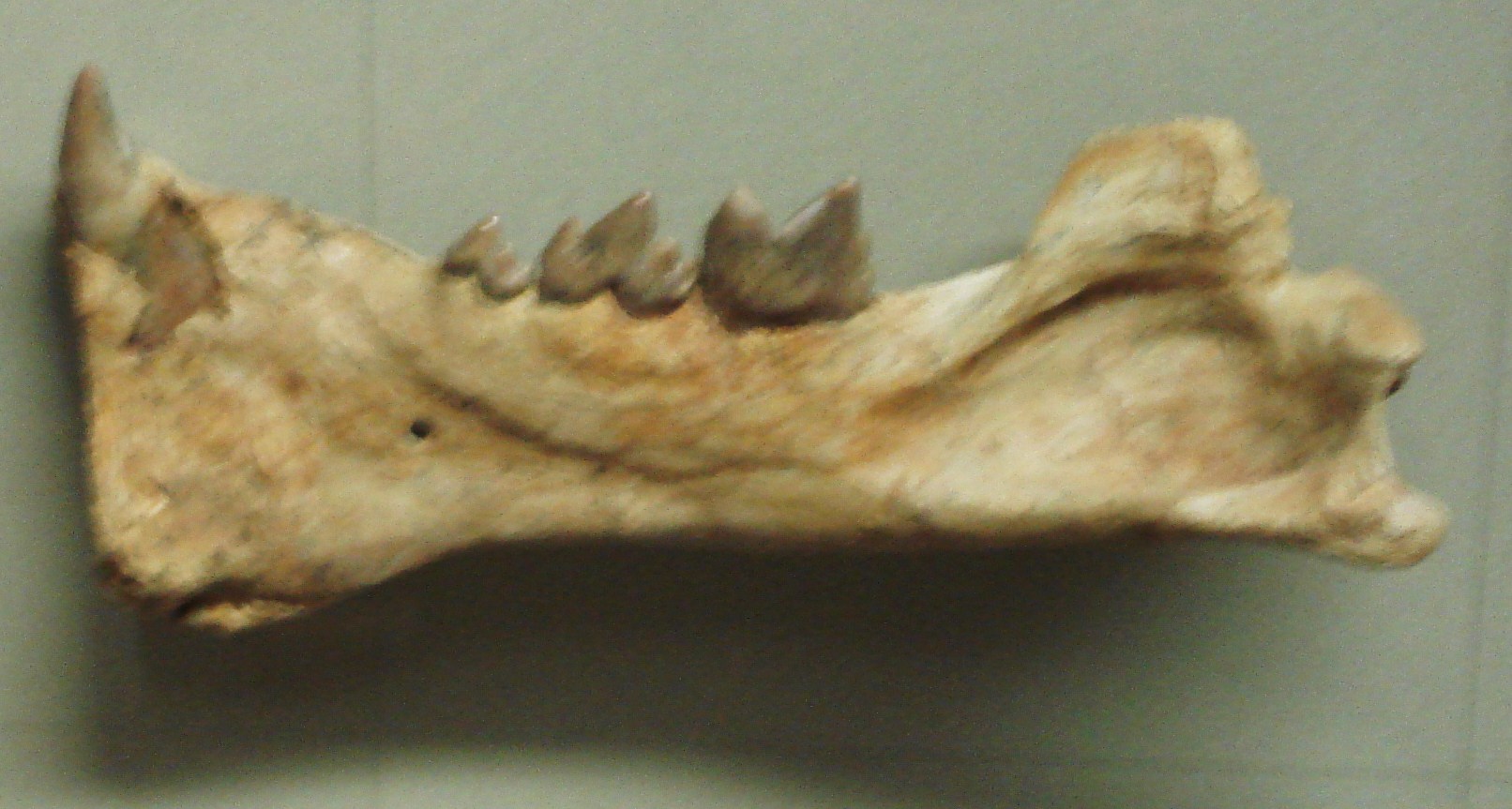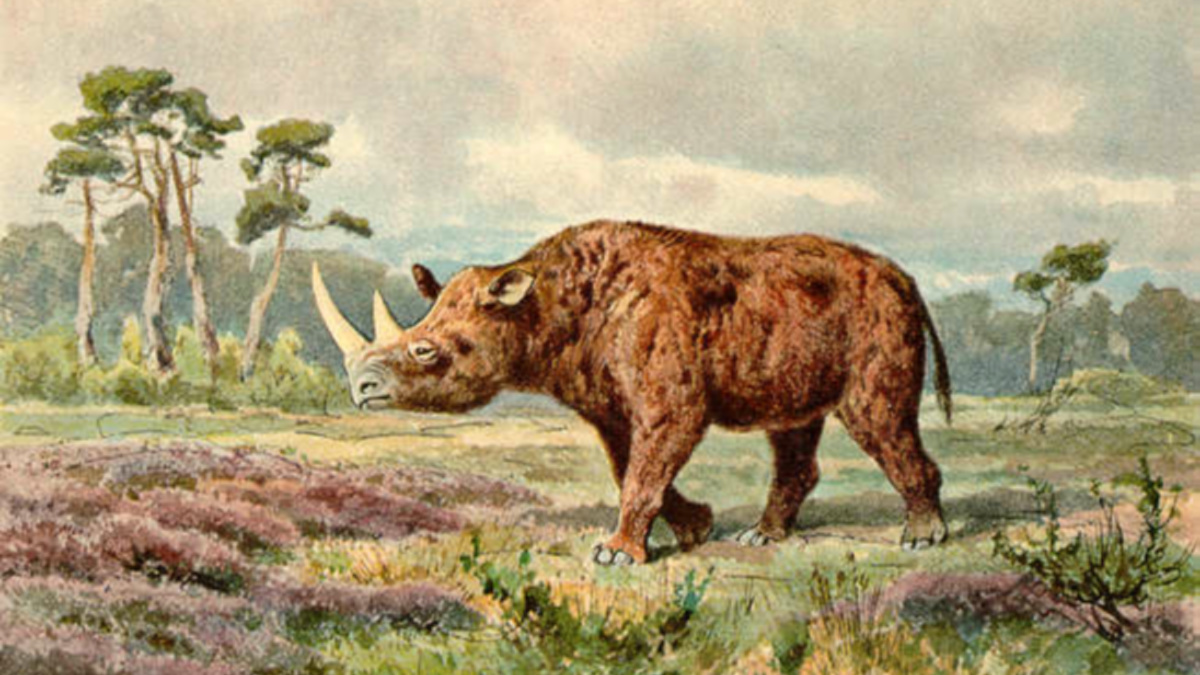|
|
Post by Talira Greycrest on Nov 9, 2024 10:17:30 GMT
Name: Thoatherium
Pronunciation: Thow-ah-thee-ree-um
Meaning of name: "Active swift beast" or "Swift mammal"
Species: T. bilobatum, T. karaikense, T. minusculum, T. rhabdodon, T. velatum
Size: Depending on species, measured around 0.7 metres long, 0.45 metres tall and weighing between 6 and 11kgs.
Family: Proterotheriinae (a subfamily of Proterotheriidae)Diet: HerbivoreFirst fossils found: Known from several specimens discovered in the Santa Cruz Formation of southern Patagonia, Argentina. T. minusculum named by Argentine palaeontologist, Florentino Ameghino, in 1887. T. rhabdodon named in 1894. T. bilobatum, T. karaikense and T. velatum named in 1904.Lived: Depending on species, lived between 17.5 and 16.3 million years ago during the Burdigalian stage of the Early Miocene in what is now southern Patagonia, Argentina. Artist's impression of T. minusculum Artist's impression of T. minusculum
|
|
|
|
Post by Talira Greycrest on Nov 10, 2024 10:11:03 GMT
Name: PaakniwatavisPronunciation: Pak-nee-wah-tay-visMeaning of name: "Water Spirit bird", in reference to the supernatural 'water spirits' or 'water babies' of Shoshoni legend.Species: P. grandeiWingspan: Uncertain due to a lack of fossils.Family: UncertainDiet: Uncertain. Possible carnivore.First fossils found: Known only from a single, mostly complete skull and skeleton, discovered in the Green River Formation of Wyoming. Named by Grace Musser and Julia A. Clarke, in 2024.Lived: 52 to 51 million years ago during the Ypresian stage of the Early Eocene in what is now the western United States. Photo and line drawing of P. grandei fossil. Photo and line drawing of P. grandei fossil.
|
|
Tix Mascot
Tech guru
Italy is my second homeland
Posts: 11,093  Mini-Profile Background: {"image":"http://4.bp.blogspot.com/-X5mhw13BJ7Y/TwKeZ3uM7YI/AAAAAAAABPw/D82go4Ny_8E/s1600/italy-background-8-787281.jpg","color":""}
Mini-Profile Text Color: 0ef8f1
Mini-Profile Name Color: f40d39
Year of Birth: 1961
Nationality: Norwegian
Mini-Profile Background: {"image":"http://4.bp.blogspot.com/-X5mhw13BJ7Y/TwKeZ3uM7YI/AAAAAAAABPw/D82go4Ny_8E/s1600/italy-background-8-787281.jpg","color":""}
Mini-Profile Text Color: 0ef8f1
Mini-Profile Name Color: f40d39
Year of Birth: 1961
Nationality: Norwegian
|
Post by Tix Mascot on Nov 10, 2024 12:24:24 GMT
Was it a side branch of the horses' family tree? Thanks! That was enlightening.  |
|
|
|
Post by Talira Greycrest on Nov 11, 2024 10:02:38 GMT
Name: ProsansanosmilusPronunciation: Pro-san-san-o-smy-lusMeaning of name: "Before Sansanosmilus"Species: P. peregrinus, P. eggeriSize: Uncertain due to a lack of fossils.Family: Barbourofelidae Diet: CarnivoreFirst fossils found: Known from numerous specimens discovered in France and Germany. P. peregrinus named by E. P. J. Heizmann, L. Ginsburg and C. Bulot in 1980. P. eggeri named by Michael Morlo, Stephane Peigné and Doris Nagel in 2004.Lived: Depending on species, lived between 20 and 7.246 million years ago from the Burdigalian stage of the Early Miocene through to the Tortonian stage of the Late Miocene in what is now France and Germany. P. peregrinus mandible P. peregrinus mandible
|
|
|
|
Post by Talira Greycrest on Nov 12, 2024 9:59:57 GMT
Name: PriscakoalaPronunciation: Priss-ka-ko-ah-lahMeaning of name: "Ancient koala"Species: P. lucyturnbullaeSize: Uncertain due to a lack of fossils.Family: PhascolarctidaeDiet: HerbivoreFirst fossils found: Known only from two partial skeletons discovered in the Riversleigh World Heritage Area of northwestern Queensland, Australia. Named by Australian palaeontologists, Karen H. Black, Michael Archer and Suzanne J. Hand, in 2012.Lived: 20.44 to 15.97 million years ago during the Burdigalian stage of the Early Miocene in what is now northwestern Queensland, Australia.
 Partial left jawbone and teeth of Priscakoala. Partial left jawbone and teeth of Priscakoala.
|
|
|
|
Post by Talira Greycrest on Nov 13, 2024 8:51:03 GMT
Name: MesembriornisPronunciation: Me-sem-bri-or-nisMeaning of name: "Southern bird"Species: M. incertus, M. milneedwardsiSize: Depending on species, stood between 1.4 and 1.7 metres tall and weighing up to 70kgs.
Family: Mesembriornithinae (a subfamily of Phorusrhacidae)Diet: Carnivore
First fossils found: Known only from fragmentary specimens discovered in the Monte Hermoso Formation of southern Argentina. M. milneedwardsi named by Argentine palaeontologist, Francisco Pascasio Moreno, in 1889. M. incertus named in 1914.
Lived: Depending on species, lived between 5.332 and 4 million years ago from the Zanclean stage of the Early Pliocene through to the Gelasian stage of the Early Pleistocene in what is now southern Argentina. Artist's impression of Mesembriornis hunting a lone Hinasuri Artist's impression of Mesembriornis hunting a lone Hinasuri
|
|
|
|
Post by Talira Greycrest on Nov 14, 2024 12:03:05 GMT
Name: ParacraxPronunciation: Pah-rah-craxMeaning of name: "Near curassow", in reference to one of the three major groups of cracid birds.Species: P. antiqua, P. gigantea, P. wetmoreiSize: Depending on species, estimated to have stood between 1 and 2 metres tall and weighing up to 190.5kgsFamily: Uncertain. Possible Bathornithid.Diet: CarnivoreFirst fossils found: Known from numerous specimens discovered in the western and midwestern United States. First discovered by American palaeontologist, Othniel Charles Marsh, in Colorado in 1871. P. antiqua named in 1964. P. gigantea and P. wetmorei named in 1968. Lived: Depending on species, lived between 33 and 30 million years ago during the Rupelian stage of the Early Oligocene in what is now the western and midwestern United States. Artist's impression of Paracrax hunting Osbornodon and Miohippus. Artist's impression of Paracrax hunting Osbornodon and Miohippus.
|
|
|
|
Post by Talira Greycrest on Nov 15, 2024 10:10:09 GMT
Name: Eutreptornis Pronunciation: Yoo-trept-or-nisMeaning of name: "Changing bird"Species: E. uintaeSize: Uncertain due to a lack of fossils.Family: Uncertain. Possible Bathornithid.Diet: Uncertain. Likely carnivore.First fossils found: Known only from two leg bones discovered in the Uinta Formation of northeastern Utah. Named by American palaeontologist, Joel Lester Cracraft, in 1971.Lived: 46.2 to 40.4 million years ago during the Lutetian and Bartonian stages of the Middle Eocene in what is now the western United States.
 Bathornithidae: Eutreptornis uintae (1), Bathornis grallator (2), Bathornis veredus (3), Bathornis geographicus (4), Bathornis fax (5), Paracrax wetmorei (6), Paracrax gigantea (7) Bathornithidae: Eutreptornis uintae (1), Bathornis grallator (2), Bathornis veredus (3), Bathornis geographicus (4), Bathornis fax (5), Paracrax wetmorei (6), Paracrax gigantea (7)
|
|
|
|
Post by Talira Greycrest on Nov 16, 2024 13:13:34 GMT
Today's entry is the largest known freshwater turtle:
Name: StupendemysPronunciation: Stu-pen-dem-issMeaning of name: "Astonishing turtle" or "Stupendous turtle"
Species: S. geographica, however, there may be a second species.Size: Largest known specimens have a carapace length of around 2.86 metresFamily: PodocnemididaeDiet: Uncertain. Likely omnivore.First fossils found: Known from several specimens discovered in the Pebas Formation of western Brazil and the Urumaco Formation of Venezuela. Named by Roger C. Wood in 1976.Lived: 13 to 5 million years ago Serravallian stage of the Middle Miocene through to the Zanclean stage of the Early Pliocene in freshwater environments in what is now Venezuela and western Brazil. Skull and mostly complete carapace of a subadult Stupendemys. Skull and mostly complete carapace of a subadult Stupendemys.
|
|
|
|
Post by Talira Greycrest on Nov 17, 2024 12:33:23 GMT
Name: ElasmotheriumPronunciation: E-las-moe-thee-ree-umMeaning of name: "Laminated beast", in reference to the laminated folding of the tooth enamel.Species: E. sibiricum, E. caucasicum, E. chaprovicum, E. peii, E. primigeniumSize: The largest species, E. caucasicum, estimated to have measured around 5 metres long and weighing between 3 and 5 metric tonnes.Family: Elasmotheriinae (a subfamily of Rhinocerotidae)Diet: HerbivoreFirst fossils found: Known from several specimens including almost complete skeletons discovered across Eastern Europe and Central Asia. E. sibiricum named by Saxon palaeontologist, Gotthelf Fischer von Waldheim, in 1808. E. caucasicum named in 1914. E. peii named in 1958. E. chaprovicum named in 2004. E. primigenium in an unknown year. Whilst we don't know for certain, Elasmotherium is thought to have had a keratinous horn, similar to that of modern rhinos.Lived: Depending on species, lived between 7 million and 39,000 years ago from the Messinian stage of the Late Miocene through to the Tarantian stage of the Late Pleistocene across what is now Eastern Europe and Central Asia. Artist's impression of E. sibiricum Artist's impression of E. sibiricum
|
|
|
|
Post by Talira Greycrest on Nov 19, 2024 9:01:26 GMT
Name: BorhyaenaPronunciation: Bor-hy-e-nahMeaning of name: "Strong hyena"Species: B. macrodonta, B. tuberata Size: Depending on species, estimated to have measured around 1.5 metres long, 0.5 metres tall and weighing up to 23kgs.Family: BorhyaenidaeDiet: CarnivoreFirst fossils found: Known from several specimens discovered in the Río Frías Formation of Chile and the Santa Cruz and Sarmiento Formations of Patagonia, Argentina. B. tuberata named by Argentine palaeontologist, Florentino Ameghino, in 1887. B. macrodonta named by Mr. Ameghino in 1902. Despite its name, Borhyaena isn't related to hyenas.Lived: Depending on species, lived between 21 and 15.5 million years ago from the Aquitanian stage of the Early Miocene through to the Langhian stage of the Middle Miocene in what is now Chile and Patagonia, Argentina.
 B. tuberata skull on display at London's Natural History Museum B. tuberata skull on display at London's Natural History Museum
|
|
Tix Mascot
Tech guru
Italy is my second homeland
Posts: 11,093  Mini-Profile Background: {"image":"http://4.bp.blogspot.com/-X5mhw13BJ7Y/TwKeZ3uM7YI/AAAAAAAABPw/D82go4Ny_8E/s1600/italy-background-8-787281.jpg","color":""}
Mini-Profile Text Color: 0ef8f1
Mini-Profile Name Color: f40d39
Year of Birth: 1961
Nationality: Norwegian
Mini-Profile Background: {"image":"http://4.bp.blogspot.com/-X5mhw13BJ7Y/TwKeZ3uM7YI/AAAAAAAABPw/D82go4Ny_8E/s1600/italy-background-8-787281.jpg","color":""}
Mini-Profile Text Color: 0ef8f1
Mini-Profile Name Color: f40d39
Year of Birth: 1961
Nationality: Norwegian
|
Post by Tix Mascot on Nov 19, 2024 16:36:41 GMT
I'm truly impressed by the variety of species and their similarity to modern ones.
|
|
|
|
Post by Talira Greycrest on Nov 20, 2024 9:22:02 GMT
Today's entry is a well-known Ice Age mammal:
Name: Coelodonta Pronunciation: See-low-don-tahMeaning of name: "Hollow tooth"Species: C. nihowanensis, C. antiquitatis, C. thibetana, C. tologoijensisSize: Depending on species, measured up to 3.8 metres long, 2 metres tall and weighing between 1 and 1.5 metric tonnesFamily: RhinocerotidaeDiet: HerbivoreFirst fossils found: Known from several specimens, including animals whose entire bodies (skin, fur and internal organs) have been preserved, discovered across Europe and Asia. C. antiquitatis named by Johann Friedrich Blumenbach in 1799. C. tologoijensis named in 1966. C. nihowanensis named in 1978. C. thibetana named in 2011. Also known as the Woolly Rhino due to its complete covering of fur. Lived: Depending on species, lived between 3.7 million and 14,000 years ago from the Zanclean stage of the Early Pliocene through to the Tarantian stage of the Late Pleistocene across what is now Europe and Asia. Artist's impression of C. antiquitatis Artist's impression of C. antiquitatis
|
|
Tix Mascot
Tech guru
Italy is my second homeland
Posts: 11,093  Mini-Profile Background: {"image":"http://4.bp.blogspot.com/-X5mhw13BJ7Y/TwKeZ3uM7YI/AAAAAAAABPw/D82go4Ny_8E/s1600/italy-background-8-787281.jpg","color":""}
Mini-Profile Text Color: 0ef8f1
Mini-Profile Name Color: f40d39
Year of Birth: 1961
Nationality: Norwegian
Mini-Profile Background: {"image":"http://4.bp.blogspot.com/-X5mhw13BJ7Y/TwKeZ3uM7YI/AAAAAAAABPw/D82go4Ny_8E/s1600/italy-background-8-787281.jpg","color":""}
Mini-Profile Text Color: 0ef8f1
Mini-Profile Name Color: f40d39
Year of Birth: 1961
Nationality: Norwegian
|
Post by Tix Mascot on Nov 20, 2024 17:03:00 GMT
Not so different from a modern rhino, perheps a tiny bit more wooly.
|
|
|
|
Post by Talira Greycrest on Nov 21, 2024 11:45:02 GMT
Name: MoropusPronunciation: More-oh-pusMeaning of name: "Sloth foot" or "Slow foot"Species: M. distans, M. elatus, M. hollandi, M. matthewi, M. merriami, M. oregonensis, M. senexSize: Depending on species, measured up to 3 metre long, 2.4 metres tall and weighing between 1 and 1.7 metric tonnes.Family: Schizotheriinae (a subfamily of Chalicotheriidae)Diet: HerbivoreFirst fossils found: Known from several individuals discovered in the western, midwestern, south-central and southeastern United States. M. oregonensis named by American palaeontologist, Joseph Mellick Leidy, in 1873. M. distans, M. elatus and M. senex named in 1877. M. hollandi named in 1907. M. matthewi named in 1913. M. merriami named in 1914.Lived: Depending on species, lived between 20.4 and 13.6 million years ago from the Aquitanian stage of the Early Miocene through to the Serravallian stage of the Middle Miocene in what is now the western, midwestern, south-central and southeastern United States. Size comparison between M. elatus and a human Size comparison between M. elatus and a human
|
|